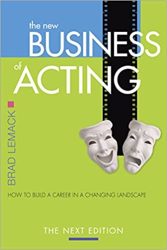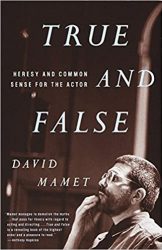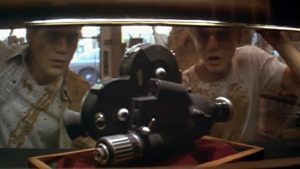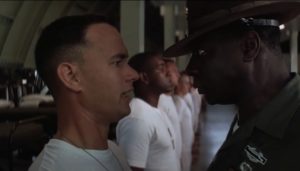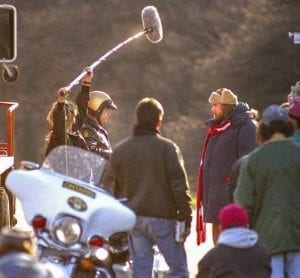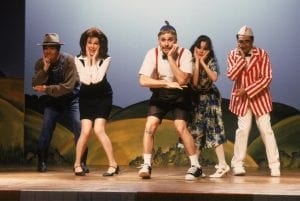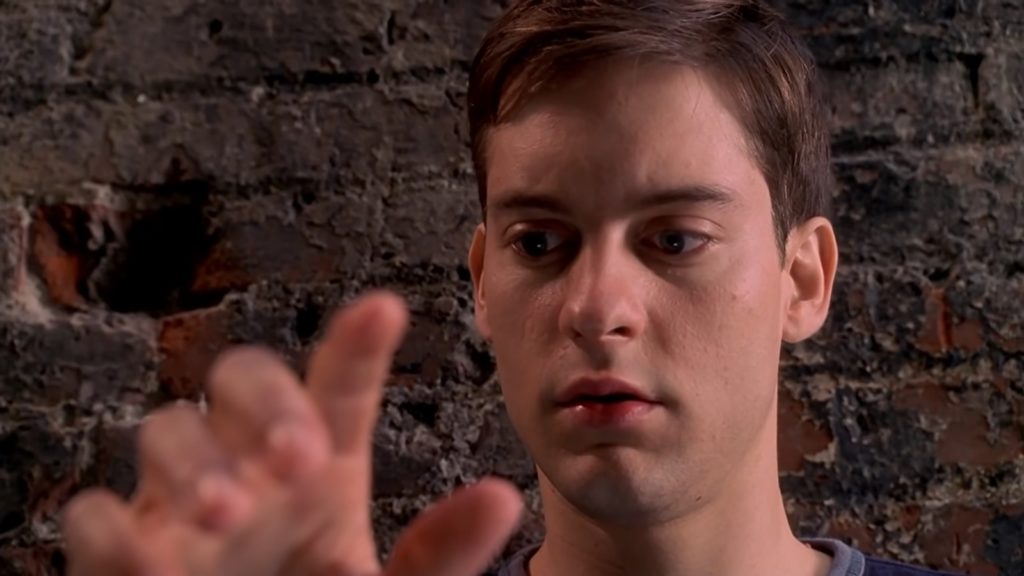
As an actor, you’re given things to say but often they don’t tell what you can do with your hands. This article gives ideas about things you can do with your hands.
You can use your hands to interact with people (such as by circularly moving your hand to encourage someone to keep talking) and show how you feel (such as by snapping your fingers imaginary music). You can also incorporate props into your hand gestures, such as by using a pen to point at something.
This article gives 50 ideas of possible hand gestures as well as some ideas about what you can do with props such as a pen, mug, or cell phone. Hopefully going through these lists helps free your creativity when it comes to using your hands when acting.
50 ideas for hand gestures
Before we start, as a mental warmup, you can notice the great variety of hand gestures that the genie uses in the video below:
Now, keeping in mind that there are many more possibilities, here are 50 ideas for hand gestures:
- Putting your hand to your chest to show that you are talking about yourself or to show that you are honest.
- Hands can be on your hips or in your pockets, or you might have your arms sideways to help you balance.
- Waving to someone, with one or both hands. It could also be a royal wave with fingers tightly together and slightly curved.
- Putting an object down on a surface and moving it away from you slowly.
- Shaking your finger to show that something is significant or to warn someone not to do something.
- Hand to cheek, as if thinking. Or you could be touching your chin with your index finger when lost in thought. Using one hand to hold the side of your face, often with your elbow resting on the back of a chair or desk
- Using fingers to show numbers or size/height.
- Having your hands behind your head while sitting down or lying down.
- Snapping your fingers to get someone’s attention or to a musical rhythm.
- Symbolizing “stop” by extending your arm outward with your palm facing outward.
- Fixing up your appearance, such as by brushing your hair back, adjusting your tie, or smoothing out wrinkles from clothing.
- Touching your chin/mouth, tapping the side of your nose with your finger while thinking.
- Sticking your hand out, palm up, as if asking for something.
- Holding hands with someone, with or without interlaced fingers.
- Beckoning someone by extending your entire arm towards them or waving towards yourself with your hand or moving a curled finger towards yourself.
- Saluting, either formally or sloppily.
- Resting one arm against the back of someone else’s chair or resting one arm on a table or against a wall.
- Putting your hands out in front of you as if protecting yourself, or palms up in resignation.
- Using two hands (rather than one) to pick up an object, such as a glass or a bottle.
- Scratching the side of your face, rubbing the back of your neck, pulling your ear, holding the back of your head with your hand.
- Having your hands behind your back, or having your arms crossed, or holding one arm with the other hand.
- Showing that something is on a higher level by having a downward-facing palm in front of you and then moving it upward (to show growth) or using your other hand to make another downward-facing palm higher that’s than the first.
- Rubbing hands together, or having steepled fingers, like a mastermind.
- Tapping fingers on desk/table (when seated), out of nervousness/frustration or to music, or knocking on something.
- Patting the top of another person’s hand or overlapping your hands with another actor’s hand in between them.
- Miming something to illustrate what you’re talking about. For example, you can mime something related to sports (such as pretending to shoot a basketball) or music (such as pretending to play the violin) or everyday tasks (such as opening a door or typing).
- Shaking someone’s hand or doing a fist bump or high five.
- Interlacing your fingers and stretching your arms out with palms outward, as if you’re stretching and about to do something impressive.
- Spreading your fingers apart until you feel tension in them, opening and closing your hand
- Moving your hand in a circular way to signal someone to continue talking.
- Brushing your hair out of your face or biting nails.
- Having your hands on your thighs while sitting or by your sides while standing, or sitting on your hands.
- Showing that something should clearly make sense by shaking your hand like a violinist’s vibrato or like the stereotypical Italian hand gesture.
- Gripping something tightly in your hand or placing an object on a table or flat surface with authority.
- Face palm, putting your hands to your face as if stressed, or covering your eyes.
- Thumbs up/down, various rude gestures, air quotes, heart sign, the “V” peace/victory sign, the time out sign, the OK sign, the telephone sign, etc.
- Moving two fingers to represent a walking person.
- A light touch on the shoulder of friend or loved one. Putting your hand on someone’s shoulder could also be used for emphasis when making a strong point. Tapping someone on the shoulder could also be used to get their attention.
- Playing with an object such as a pen or a watch. You could also be fidgeting with an object in your pocket.
- Clasping hands in front of face, as if praying or beseeching. Or you could place palms flat against each other and then lift them slowly to the sky.
- Picking imaginary lint off of yourself or off someone else’s clothes.
- Making a fist. This could be one hand or both, and the position of the fist can change. For example, one hand might be clenched tightly into a fist and held against the side of the leg. Another example is clenching both fists and holding them clenched against your head. Or raising one fist in defiance.
- Setting both hands on either side of you, pushing yourself up from a lying or sitting position.
- Hand to forehead, as if checking a headache.
- Holding your stomach in pain or discomfort.
- Brushing sideways through the air with your palm outwards, like when you’re encouraging someone to imagine a certain amazing place.
- Pointing your finger at the person you are talking to. A more extreme version of this could be touching the other actor with an outstretched finger for emphasis when making a strong point.
- Dragging one hand along a surface or touching something/someone that isn’t there.
- Fluttering hands to indicate nervousness or discomfort.
- Clapping your hands, slowly or quickly.
Hand movements with props
Having a prop can help give even more options for things you can do with your hands. As an introduction, check out the comedy skit below:
Now that you’re in a creative mood, here are some ideas about how you can incorporate some common props (a pen, mug, and cell phone) into your hand gestures:
12 ideas for hand movements with a pen
- Writing on a paper.
- Putting the pen away into a holder.
- Twirling then pen in your fingers.
- Throwing the pen up in the air and catching it.
- Scratching your head/face/neck with the pen.
- Holding your pen while having arms crossed.
- Rolling the pen between palms of hands.
- Holding the back of the pen in teeth.
- Tapping with a pen on something (for example, a table, chair, or leg).
- Conducting music or using your pen to tap on something.
- Using a pen to point.
- Using a pen to pick at something.
12 ideas for hand movements with a mug
- Holding the mug by the handle, drinking from it, and putting it back down. Or you can just constantly hold it by the handle without drinking from it.
- Taking a sip from the mug and holding it while looking away or taking a sip from the mug and then freezing mid-sip.
- Raising the mug up to take a sip but then putting it back down without drinking.
- Throwing the mug up in the air and catching it.
- Destructive actions, such as throwing the mug on the ground (it shatters) and then picking up the pieces.
- Spilling the liquid from the mug onto the ground or onto something else like hands. This could be accidental, such as with an elbow, or deliberate, such as by holding the mug and turning it entirely upside down. The liquid from the mug could also be sent flying sideways. You could also be wiping off a spill on the mug.
- Reaching for the mug slowly before picking it up carefully, as if afraid of being burned by hot coffee. You could also be warming your hands against the mug.
- Picking up the mug and examining it before putting it down again; for example, it could be a special mug, or you could be looking to see if there is lipstick on the rim of the mug or not. You can also pick up the mug and examining the bottom of the mug.
- Swirling around the liquid in the mug or twirling or spinning the mug around.
- Raising a mug as if giving a toast before taking a sip.
- Drumming fingers against a mug.
- Offering the mug to someone else.
12 ideas for hand movements with a cell phone
- Taking a call.
- Resting your chin on the cell phone as you speak.
- Reading a text or on the screen.
- Typing something on the cell phone, such as a text message or to unlock the phone.
- Putting the cell phone away into your pocket or bag (or getting it out from there).
- Picking up a phone to decline a call before placing it screen-down on the table.
- Turning off the alarm on the cell phone.
- Taking a selfie or photo or using the phone as a mirror.
- Swiping up or sideways on the phone (with the index finger or thumb) or moving the thumb and index finger on the screen to zoom in/out on the phone.
- Showing someone something on your cell phone.
- Using a phone as a flashlight.
- While on a call, temporarily using your hand to cover the phone to say something to someone beside you.
Reflection exercises about hand gestures
You can learn so much about hand gestures simply by observing people. As an introduction, the video below shows a grandfather as he just finds out that the newborn has been named after him. Take a look at his hand gestures – he does them without thinking.
When you find yourself daydreaming or when you’re talking to someone you know, perhaps take a moment to notice what hand gestures you’re using to get a sense of what you do naturally. Your findings may surprise you. Maybe it turns out that you play with your clothes, maybe one of your hands is on the table and you hadn’t even noticed, or maybe you make certain finger movements just because you enjoy them. You can also observe other people’s hand movements as well, especially when their mind is elsewhere and they’re not thinking about their hands. Perhaps you might want to incorporate those hand movements into your repertoire too.
You can also reflect on the compatibility of hand gestures with different states of being. For example, when you’re noticing your hands, you can also notice to see what your posture is like. Perhaps your whole body is doing something. You can also check out the article about how body language can be expressed through walk, and you can think about what kinds of hand movements (or hand stillness) can make sense there.
You can also consider how the same hand gesture can be performed in different ways. For example, clapping can be enthusiastic, or it can be sarcastic, or it can be the kind of clapping that encourages the rest of the crowd to clap. Or another example is pointing; consider the difference between the pointing of someone who really wants others to see something, versus the pointing of someone who is lazy and doesn’t feel like moving, versus the pointing of someone who had been looking for something for a long time and has finally found it.
Happy observation and experimentation.



